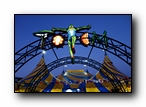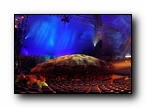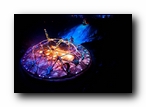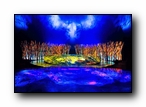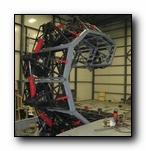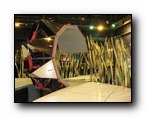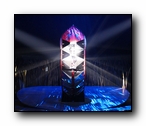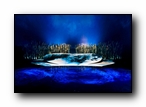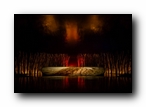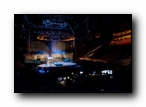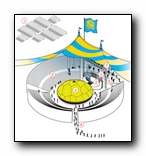
![]()

[ You are here: Grand Chapiteau | Creations | TOTEM | Scénographie ]
Création
Expérience
RéserveRetiré
Odyssey
Laliberté had been trying to lure Lepage back to the big top since he directed KA, Cirque’s theatrical offering at the MGM Grand in Las Vegas, in 2004. Lepage refused; the internationally-acclaimed playwright, actor and director was busy appearing in theatrical works and directing operas. Two years later, Laliberté asked: “What do you want to do?” Lepage’s answer: an intimate tent show, inspired by the 200th anniversary of Charles Darwin’s birth. “I wanted to do something that would be about evolution,” he says. “Evolution is about the body, how you go from a nucleus to an amphibian to a mammal to standing upright and eventually flying. There’s enough space in that idea to go into the origins, go into the past, talk about the present and project ourselves into some sort of poetic ideal.” TOTEM traces the fascinating journey of the human species from its original amphibian state to its ultimate desire to fly. The characters evolve on a stage evoking a giant turtle; the tortoise is symbolic (or totemic) within many cultures, he explained. Inspired by many founding myths, TOTEM illustrates, through a visual and acrobaticlanguage, the evolutionary progress of species. Somewhere between science and legend TOTEM explores the ties that bind Man to other species.
Bordering the upstage is the marsh and stream. Tilted slightly forward, the image marsh acts both as a stage entrance and as a projection surface. Through the magic of moving images it becomes a virtual swamp, a river source, a marsh, a lake, an ocean, a volcanic island, a pond and a starry sky. The reeds conceal the artists and some set elements before they enter. To save weight and facilitate storage on tour, the reeds are inflatable. But the reeds aren’t the real shocker in this set's design... it's the Scorpion Bridge. The “Scorpion Bridge” serving as a mobile platform connects the marsh to the scene features variable geometry, allowing it to adapt to each tableau. In one of the clown numbers, for example, it becomes the prow of a boat then rises to become a plane in flight, and finally a rocket taking off. In another scene, the bridge is configured to look like a vertical totem pole. During the rings trio number, the Scorpion Bridge turns into an Indian carpet that unrolls on the beach in a reference to the Bollywood aesthetic that inspired the overall look of this scene. The concept of the Scorpion Bridge was loosely based on a retractable pedestrian bridge in London. Built of steel and weighing 10,000 lbs, its 8 powerful mineral oil hydraulic motors allow it to rise, descend, extend, retract and curl in on itself like a scorpion’s tail. Its reflective surfaces, which shine like mirrors, are made of stainless steel plates. The base of the bridge houses lighting equipment, a laser, speakers and cameras. During the show, the bridge is monitored by an operator using four infrared cameras. At the back, the musician’s platform, approximately 10 feet off the ground.
The lighting in Totem intentionally extends the colors in the projections of the marsh, using colors that Boucher borrowed from nature, with greens and blues inspired by ice, and the reds and yellows by fire. "In Totem, each mast has 11 James Thomas Engineering PARs, five ETC Source Fours, and two Clay Paky Alpha Spot HPE 1500s. The conventionals are stacked so they are 10 units high by two wide, with the same symmetrical arrangement on all four masts to give a similar view to everyone." Boucher added A.C. Lighting Chroma-Q Plus scrollers to ensure a diverse range of color combinations. "There is a Clay Paky 1500 placed low and high on each mast to give a good angle on almost everything," adds Penney, who notes that the upstage two masts have extra ETC Source Fours as specials, as well as Clay Paky Alpha Beam 700s to create air effects. A grid houses an additional 16 PARs with scrollers for toplight color, as well as an arrangement of Source Fours with breakup gobos that create a full wash on stage. "There are also three Clay Paky 1500s spread out for good coverage," Penney points out. Just upstage of the grid is a truss that links the two upstage masts together. This supports the three projectors that cover the marsh projection surface, which also serves as an entrance onto the playing area, or island, where the primary scenic element looks like a large, abstract turtle carapace that functions as both a decorative piece and acrobatic equipment. At the center of the marsh is a hydraulic bridge, built by Scène Éthique, with seven main axes of movement allowing it to travel upstage and downstage plus lift and lower in different combinations, creating anything from a wooden bridge to the clowns’ water ski boat and a vertical totem pole. The underside of the bridge houses lasers, loudspeakers, lighting equipment, and cameras. Additional Source Fours with scrollers provide backlight and light the reeds upstage, while three small trusses hung over the audience add lower front fill. "There were many rehearsals during creation whose only purpose was to validate the lighting looks," says Penney. "Basically, it was a long process of Etienne making the looks and then making sure that they would work with the artists." Lighting and projections are run by the same operator but on separate cue stacks. "We chose this method just in case there were any problems, one would not affect the other," Penney says. "We have a main MA Lighting grandMA2 light plus one as full backup, and we have three media servers: a main, a backup, and a controller." As Penney notes, Cirque du Soleil big top tours are much different from the typical load-in and load-out schedule of an arena, Broadway, or rock ‘n’ roll tour. "We pack up everything with us," he says. "Load-out takes about eight hours for lighting and sound, and about 12 for carpentry, automation, and rigging. Load-in takes eight days, but it takes approximately 30 hours for lighting to set up and six to eight hours for focus of conventional and moving light positions, and projection focus." The last three days of load-in are for training and to get the big top site ready for public. "In addition to the setup time, we have eight to 10 hours of maintenance with all of our equipment on the ground every load-in while the big top is being built," Penney points out. "We check the focus of the lights and projections before every show, so we can make sure every show is as good as the last. The design, I feel, really pulls the audience in. The difficulty we have in the big tops is that there are very limited positions to hang lights. Etienne did a very good job of using the positions available to give every seat in the house an excellent view of the show."
Cascading images of water in every imaginable form set the scene. "The basic idea was to create a marsh, an animated watery surface from where life emerges," says image content designer Pedro Pires. Totem is a visual feast where the projections and lighting create a series of natural environments (lake, ocean, pond, volcano) in which an upstage raked platform, designed as a marsh bordered with reeds, serves as the main projection surface."I thought a concept of metamorphosis between images could be interesting to simply illustrate the idea of evolution in the show," explains Pires. To do this, his images embrace natural phenomena such as erosion, evaporation, melting, freezing, growing, etc. "I began to think of a watery surface that, at a certain point, dries out, leaving only sandy ground. Then, an earthquake would break that ground revealing flowing lava. The cold lava would bring minerals and crystal found in metals, and so on." The imagery segues seamlessly from one scene to another, morphing from the clowns in the show water skiing with a boat that turns into a plane, to a rocket that explodes in the sky, setting fire to the reeds all around the stage to create an aboriginal ceremony. "The reeds can also be seen as the hair of a giant aboriginal mask on which the people evolve," says Pires, whose landscapes of outer space were derived from actual photos shot by Cirque du Soleil’s founder and artistic guide Guy Laliberté in his Poetic Social Mission aboard the International Space Station. "I went to his house to see his footage, and he gave me a photo bank of 9,000 space images," notes Pires, who modified some of these images to fit the blue black-light ambience of the Russian Bars number in which cosmonauts are trying to break free of the Earth’s gravity. At another moment, Pires has grass grow over the blue planet to create a moving underwater seascape for the arrival of frogs and beach acrobats coming out of the screen. "This sequence was shot in a pool with acrobats in costumes and makeup," he explains. "The trajectory and the size of the characters had to be very precise to fit with the live characters seen against the projections. I wanted all of the projections in Totem to be realistic, as if we are there, as if we are traveling through different regions of the world, in different times, and as if the acrobats on stage are evolving beside real water surfaces." Pires found inspiration in nature itself, travelling to various locations, including Iceland, Hawaii, and Guatemala, to shoot the environments. "I had to shoot them myself with a specific angle to fit the stage and the viewing angle of the spectator," he says. "I shot the lava flowing in the sea in Hawaii, but there was too much security at the site, and we were too far to see the red burning lava. In Guatemala, there was no security perimeter around the active lava site of the Pacaya volcano. We climbed up an hour in the mountain and arrived just a few feet from the red-hot flowing lava. Children were dipping wood sticks directly in the lava." Pires was lucky: Pacaya erupted six months later killing three people. With three VYV Photon Show media servers feeding images to four Christie Digital Roadster S+20K projectors, some of the images are interactive in real-time with a system of infrared cameras to make the images highly kinetic. "I wanted the projections to be ‘alive’ in the storytelling of the show yet not too distracting for the acrobatic numbers," notes Pires, pointing out that "one review says that the buildings surrounding the big top seem very dull after the show compared to what they experienced visually in Totem. That makes me happy because that’s exactly what I wanted people to feel—the sense that the magnificence of nature has somehow been evacuated from our modern civilized world, and that it’s a good thing to remember its beauty and fragility."
For sound designer Jacques Boucher, the big top offers opportunities to design massive sonic landscapes that make the most of the vast space. At the same time, it creates its own unique challenges in adapting technology to meet those artistic visions.Totem is the first Cirque production to incorporate Avid's VENUE live sound environment, with Venue Profile Systems at both front of house and monitor positions. As assistant sound designer Jean-Michel Caron explains, the Venue systems have more than met the rigorous demands of the show's intricate sound design. "Cirque productions present very complex sound design challenges," says Caron. "For some of the shows, large and complex matrix systems are used. For Totem, we wanted to find a new approach that would support Jacques' design with a less expensive system, and the Venue system turned out to be the solution we were after." "My plan for the sound design was very clear in my head," says Boucher. "Typically, this type of design would call for a system with very sophisticated matrix routing. But once I began to look at the configuration of the Venue [system], I discovered it would be possible to do everything I needed to do with it-much more than we had expected." "The Venue's ability to configure so many output busses enabled us to do a lot more than we could do with any other digital console," says Caron. "We got very creative with cue and aux busses, and ended up doing a lot of things the console was probably never designed for. But the console performed really well." "This was the first time we'd ever worked on the Venue, and we found it very easy to get used to," adds Boucher. "Even though there are a lot of possibilities, it's easy to reach whatever function you want to reach, very quickly." Boucher gives the Venue system high marks for sound quality as well. "To be honest, I never imagined the sound would be so nice," he says. "I was very pleased. Music is a very important element of this show, and the music sounds really good. And I guess people really like the music, because at the end of each show we're selling a lot of CDs." "We've been really happy with the Venue's sound quality, and also with the onboard processing," says Caron. "All the effects we're using-whether it's EQ, compression, reverbs, or anything like that-are the plug-ins that are included with the console. And the Profile is really portable, which is great for a touring production." |


